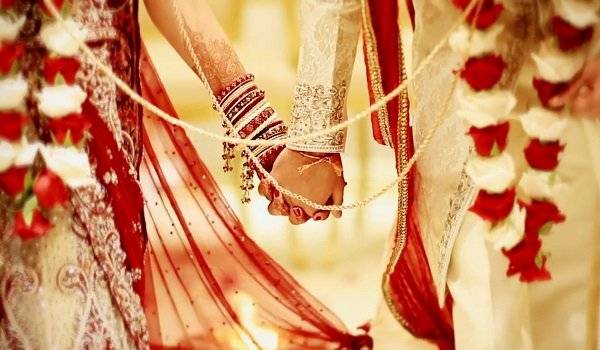Table of Contents
CEREMONIES OF A HINDU MARRIAGE – SECTION 7 OF HINDU MAARIAGE ACT, 1955
SECTION 7 OF HINDU MAARIAGE ACT, 1955
- (1) A Hindu marriage may be solemnized in accordance with the customary rites and ceremonies of either party thereto. This means that a marriage is valid if it takes place according to the ceremonies or customary rites of the bridegroom or the bride’s religion, caste, tribe, etc.
- (2) Such rites and ceremonies include the Saptapadi (taking of seven steps by the bridegroom and the bride jointly before the sacred fire), the marriage becomes complete and binding when the seventh step is taken.
- (3) State Amendments Section 7A Pondicherry: After section 7, the following section was inserted:
- (a) Each party to the marriage declares that each takes the other to be his wife or, as the case may be, her husband in whatever language they understand.
- (b) Each party to the marriage garlands the other or puts a ring upon any finger of the other; or
- (c) By the tying of the thali.
- (4) (a) Notwithstanding anything prescribed in section 7, but subject to the other provisions of this Act, all marriages to which the section applies solemnized after the enactment of the Hindu Marriage (Madras Amendment) Act, 1967, shall be legal and valid.
- (b) Notwithstanding anything contained in section 7 or in any text, interpretations or rules of Hindu law or any custom or usage as part of that law in force immediately before the commencement of the Hindu Marriage (Madras Amendment) Act, 1967, or in any other law in force immediately before such commencement or in any judgment, decree or order of any court. But subject to sub-section all marriages to which this section applies solemnized at any time, before such commencement shall be deemed to have been, with effect on and from the date of the solemnization of each such marriage, respectively, good and valid in law.
CEREMONIES OF HINDU MARRIAGE
Hindus have prescribed very elaborate rituals and ceremonies for marriage though in modern Hindu Law all of these ceremonies are not mandatory. However, the law is still uncertain about which of these ceremonies are not mandatory. Under the modern Hindu Law, a marriage may be solemnized in the following ways:
(a) By performing the shastric rites and ceremonies recognized by the Hindu laws
(b) By performing customary ceremonies which prevail in the caste, tribe or community to which one of the parties or both belong.
The status of husband and wife is constituted by performance of marriage rites either prescribed by shastras or by the custom.
SHASTRIC CEREMONIES AND RITES
For a valid Hindu marriage, performance of certain Shastric ceremonies is still necessary.
These are laid down in the grihyasutras. The grihyasutras have prescribes a very elaborate system of rites and ceremonies for a marriage. Although the performance of some ceremonies begins few days before the actual wedding at the homes of bride and bridegroom, all the essential ceremonies are performed at the bride’s place. Some important and commonly practiced shastric ceremonies are:
- (a) Vridhi Sraddha: offerings are made to the departed ancestors in order to seekh their blessings.
- (b) Sampradana: In this ceremony, the bridegroom comes to the bride’s home and water for washing feet, a mixture of honey, curd and ghee and a cushion to sit upon is given to him. Chanting of prayers is also done.
- (c) Kanyadana: father or guardian of the bride pours out a libation of water symbolizing the gift of the bride. The right hand of bride is tied with that of the groom with durva grass by chanting mantras. In this way, the bride is formally gifted to the groom.
- Dakshina (in form of gold) is also given to the groom.
- (d) Vivaha Homa: lighting of the holy fire that symbolizes divine witness and sanctifier of vivah sanskara.
- (e) Panigrahana: Groom stands facing the west and bride sits facing the east in front of
him while holding hands and the groom recites vedic hymns. - (f) Laja Homa: the offering of puffed rice to the sacred fire so that the god is pleased to free her from their bonds.
- (g) Agni Parinayana: The bride and bridegroom go around the nuptial fire and water pot three times keeping to the right.
- (h) Saptapadi: bride and groom take seven steps in the North east direction while reciting certain hymns. On completion of the seventh step the marriage becomes final and irrevocable.
CUSTOMARY RITES AND CEREMONIES
The grhiyasutras also lay down that a marriage may be solemnized according to the different customs of different tribes, villages, etc. It is settled in law that if a community does not follow shastric rituals and follow their customary rites and ceremonies then their marriage will not be considered invalid. For example: among the Santhals, the only ceremony which is necessary for solemnization of marriage is smearing of vermillion on forehead of the bride.
Another example is of the Nayahans of South India, the only ceremony necessary for marriage is tying of Nadu Veeta Thali in the neck of the bride.
Author: Khushi Maheshwari Maheshwari,
Fairfield Institute of Management and Technology (BBA LLB)

